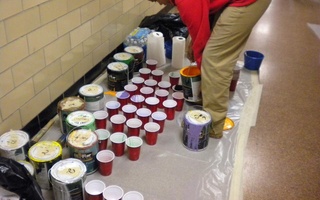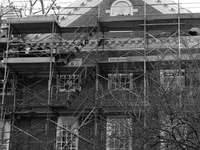
Some students say that the dearth of private common rooms in Old Quincy, the first building to undergo renovation under House renewal, does not allow them to socialize on their own terms.
With cockroach-infested rooms in Dunster, shoebox-sized doubles in Kirkland, and clogged pipes in Adams, the undergraduate residences at Harvard have in recent years become increasingly inadequate to serve the needs of the College’s students.
In 2006, Merle Bicknell, assistant dean of physical resources and planning in the Faculty of Arts and Sciences, realized that the Houses, still historically significant but also physically deteriorated, needed a full-scale renovation.
“There was a realization of the fact that these buildings were over 100 years old,” she said. “In the eight to ten weeks you get in the summertime, you can’t change out an entire [heating, ventilation, and air conditioning] system or change out all the plumbing.”
Striving to live up to the House system’s more than 80-year-old aim of creating a dynamic living-learning community, Harvard embarked on a multi-billion dollar House renewal project in 2008. The project, now in its first phases of construction, will transform the interior of the Houses and give Harvard’s residential buildings a full set of modern accommodations.
But House renewal entails more than just restoring the College’s residential facilities to tip-top physical shape.
“Improving the undergraduate experience is very much a goal of renewal,” said Quincy House Master Lee Gehrke. “It’s bricks and mortar...but the goal is broader than that. That’s done by improving the communities, but also providing new types of spaces.”
As administrators, architects, and students discuss renovation plans, they face the reality that when it comes to residential preferences, one size does not fit all.
But changes to the spatial arrangement of the Houses may also dramatically change the way students use these spaces, and House renewal presents project leaders with the opportunity to shape students’ interaction with their community.
“It really revitalizes not just the space, but the people in it,” said Stephen Lassonde, dean of student life. “It’s really a transformation in their relationship to where they’re living and their community.”
CREATING COMMUNITY
When former Harvard President Abbott Lawrence Lowell, Class of 1877, envisioned the House system in 1929, he aimed to bring Harvard’s students together in unifying communities of their peers. As the College embarks on its first comprehensive renewal effort since then, improving community remains a central goal and physical changes have been designed specifically to foster group interactions.
To adhere to rigorous Massachusetts disability laws and fire codes, architects created a residential model for Old Quincy that incorporates vertical entryways, a facet of the traditional neo-Georgian House model, and short horizontal hallways that stretch across the building and between entryways. Some areas of the House will be configured as traditional suites while others will feature “cluster communities,” in which single and double bedrooms, a bathroom, and a common room branch off from a central hallway.
Administrators said that the addition of horizontal hallways in the renovated layout will enhance social encounters in the Houses by increasing face-to-face encounters.
“Because of the old layout, the people who lived in the first floor didn’t really see the people on the fourth floor,” Gehrke said. “Now it’s going to be much, much better for informal conversations.”
Indeed, seniors who live in New Quincy said they relish the tradition of living together in suites along horizontal hallways because of the strong sense of community such a layout creates.
Read more in College News
Learning From OccupyRecommended Articles
-
John F. Kennedy Slept Here; Soon You Will TooForget "Animal House." Residential life for Harvard first-years does not involve frat houses caked with years of party residue. Nor
-
 Harvard Graduate School of Education ‘GIVES’ Inspiration
Harvard Graduate School of Education ‘GIVES’ Inspiration -
 Housing Videos: Roundup Part Deux
Housing Videos: Roundup Part Deux -
Class of 2013 Chooses Class MarshalsNina M. Yancy '13 will head the 2013 Senior Class Committee as first class marshal, the Harvard Alumni Association and the Harvard College Fund announced on Monday.
-
 Robert X. Fogarty's 'Dear World' Photography Project Exhibits Harvard Members' Individuality
Robert X. Fogarty's 'Dear World' Photography Project Exhibits Harvard Members' Individuality -
 Walking Off: FM Investigates Athletes Who Opt-out of the Program
Walking Off: FM Investigates Athletes Who Opt-out of the Program














